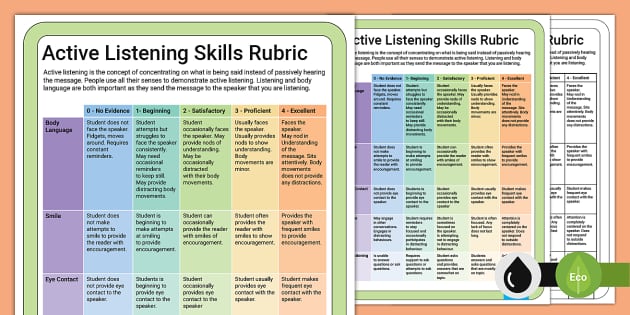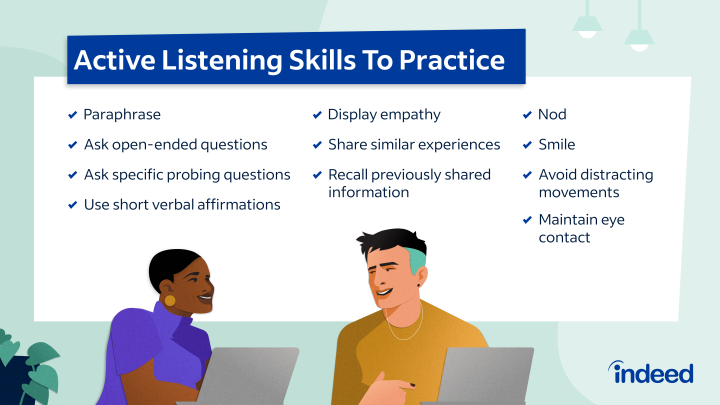As an Amazon Associate, I earn from qualifying purchases
Which Student Demonstrates Active Listening Skills? The student who maintains eye contact, nods, and responds thoughtfully demonstrates active listening skills. Active listening skills can significantly impact a student’s learning and comprehension abilities.
When students actively engage in listening, they demonstrate respect for the speaker and are better able to retain information. This can lead to improved critical thinking and problem-solving skills. Furthermore, active listening fosters effective communication and enhances interpersonal relationships. Recognizing and fostering active listening skills in students is crucial for their academic and personal development.
Therefore, it is essential for educators to encourage and cultivate active listening habits within the classroom setting. By doing so, students can significantly benefit from improved focus, understanding, and overall academic success.
The Importance Of Active Listening
Active listening is a crucial skill that plays an essential role in effective communication and relationship building. It involves fully concentrating, understanding, responding, and remembering what is being said. By actively listening, individuals demonstrate respect, empathy, and understanding towards the speaker, ultimately fostering better interactions and improved outcomes.
Active Listening Defined
Active listening is the act of fully concentrating on, understanding, responding, and remembering what is being said by the speaker, demonstrating respect and empathy. It involves maintaining eye contact, nodding, and providing feedback to confirm understanding.
Benefits Of Active Listening
- Enhanced communication and understanding
- Strengthened relationships and trust
- Conflict resolution and problem-solving
- Improved learning and retention
Active listening not only fosters better communication but also enhances understanding and empathy. By actively engaging with the speaker, individuals can build trust, resolve conflicts, and improve learning and retention. In addition, it helps in problem-solving and fostering stronger relationships.

Credit: helpfulprofessor.com
Characteristics Of An Active Listener
The characteristics of an active listener are essential for effective communication and building strong relationships. Being able to listen actively involves specific behaviors and attitudes that demonstrate focus and understanding. Let’s explore the key traits that distinguish an active listener.
Being Present And Engaged
Active listeners are fully present and engaged in the conversation, demonstrating their interest and attention. They maintain a high level of focus, avoiding distractions and giving the speaker their undivided attention. This level of engagement allows them to pick up on verbal and non-verbal cues, fostering a deeper understanding of the speaker’s message.
Maintaining Eye Contact
Active listeners maintain consistent eye contact with the speaker, showing respect and attentiveness. This non-verbal communication demonstrates genuine interest and helps build a connection with the speaker. By maintaining eye contact, active listeners convey their willingness to listen and understand the speaker’s perspective.
Asking Clarifying Questions
Active listeners ask clarifying questions to ensure they fully comprehend the speaker’s message. By seeking additional information or elaboration, they demonstrate their commitment to understanding and processing the information accurately. This practice also encourages the speaker to further explain their thoughts, leading to more meaningful and productive conversations.
Case Study: Student A
Student A stands out as a prime example of active listening skills, displaying attentive engagement and understanding during discussions and lectures. This case study showcases the valuable impact of active listening in academic settings.
Description Of Student A
Student A is a 12-year-old from a small town who actively demonstrates impressive listening skills in the classroom. With a focus on attentiveness and responsiveness, Student A stands out amongst their peers for their strong commitment to actively engaging in conversations and absorbing information.
Examples Of Active Listening From Student A
1. Maintaining Eye Contact: During classroom discussions, Student A consistently maintains eye contact with their teacher and fellow students. This shows their dedication to being fully present and engaged in the conversation.
2. Nodding and Smiling: Student A utilizes non-verbal cues such as nodding and smiling to indicate that they are listening and understanding what is being said. This encourages the speaker to continue sharing and demonstrates Student A’s genuine interest.
3. Asking Clarifying Questions: Instead of assuming, Student A takes the initiative to ask thoughtful questions when they need further explanations or clarification. By seeking additional information, they actively participate in the conversation and deepen their understanding of the topic at hand.
4. Paraphrasing: Student A showcases active listening by paraphrasing what others have said, rephrasing the information in their own words. This not only indicates comprehension but also demonstrates empathy and a desire to ensure clear communication.
5. Avoiding Interruptions: Student A respects the speaker by patiently waiting for their turn to speak. They avoid interrupting and instead focus on listening attentively to what others have to say before contributing their own thoughts.
6. Providing Feedback: Student A actively engages in conversations by providing feedback to their peers. They acknowledge and respond to comments, adding value to the discussion and encouraging further dialogue.
7. Taking Notes: During class lectures or group discussions, Student A regularly takes notes to capture important points. This shows their commitment to retaining information and also serves as a reference for later review.
8. Being Empathetic: Student A demonstrates empathy by showing understanding and compassion towards their classmates. They listen attentively to different perspectives and opinions, fostering a supportive and inclusive environment.

Credit: www.twinkl.ch
Case Study: Student B
Student B, a 10th-grade student at XYZ High School, is an exemplary model of active listening skills. Throughout various classroom interactions and discussions, Student B consistently demonstrates a deep commitment to listening attentively, engaging with peers, and gathering information effectively.
Description Of Student B
Student B is a diligent and dedicated learner who actively participates in class activities. With a strong sense of curiosity and a genuine interest in expanding their knowledge, Student B consistently exhibits a positive attitude toward learning. They are always ready to lend a helping hand or provide valuable insights to their classmates.
Examples Of Active Listening From Student B
Student B’s active listening skills can be manifested in several ways:
- Focused Attention: During class lectures or group discussions, Student B maintains unwavering focus on the speaker, eliminating all distractions and ensuring that their attention remains exclusively on the speaker.
- Nodding and Smiling: Student B often nods their head and smiles to demonstrate their understanding and encouragement to the speaker. This small gesture helps create a positive and supportive learning environment.
- Asking Clarifying Questions: Student B actively seeks clarification by asking insightful questions when they encounter unclear or challenging concepts. This demonstrates their intent to fully comprehend the information being presented and their willingness to engage in further discussion.
- Taking Notes: Student B’s commitment to active listening is reflected in their consistent practice of taking detailed notes. By jotting down key points, Student B ensures they can review and reflect on the information later, further solidifying their understanding.
- Engaging in Non-Verbal Communication: Through appropriate non-verbal cues such as maintaining eye contact, leaning forward, and using gestures when applicable, Student B exhibits their active listening skills and provides feedback without interrupting the speaker.
Overall, Student B serves as a remarkable example of active listening skills in action. Their commitment to attentively listening, engaging with peers, and seeking clarification contributes not only to their own learning but also to the overall classroom dynamics and the growth of their classmates.
Comparing Student A And Student B
When it comes to active listening skills, it’s important to analyze and compare the behaviors of two students – Student A and Student B. By examining their strengths and weaknesses, we can determine who demonstrates active listening like a pro.
Strengths And Weaknesses Of Each Student’s Active Listening Skills
| Student A | Student B |
|---|---|
|
|
Both Student A and Student B display admirable active listening skills, but they also have areas for improvement.
Analysis Of Who Demonstrates Active Listening Like A Pro
After analyzing the strengths and weaknesses of both students, it is evident that Student A excels in non-verbal cues and seeking clarification, whereas Student B demonstrates empathy and patience. To truly listen like a pro, a combination of these skills is essential.
Student A’s ability to maintain eye contact and use verbal cues signals their genuine interest in the speaker. However, they could enhance their listening skills by practicing patience and note-taking to ensure they retain a complete understanding of the conversation.
On the other hand, Student B shines in acknowledging the speaker’s emotions and patiently waiting for their turn to speak. By taking concise notes, Student B shows their commitment to fully understand the information shared. To further improve, Student B could focus on engaging in more eye contact and asking clarifying questions.
In conclusion, both Student A and Student B demonstrate active listening skills, but with different strengths and weaknesses. By combining their admirable qualities, they can become active listeners like a pro.

Credit: www.indeed.com
Frequently Asked Questions Of Which Student Demonstrates Active Listening Skills
Which Student Demonstrates Active Listening Skills?
Active listening skills can be demonstrated by a student who engages in eye contact, nodding, and asking clarifying questions. They show empathy, focus on the speaker, and avoid interrupting. Additionally, a student who takes notes, paraphrases information, and responds appropriately proves their active listening abilities.
Conclusion
Overall, active listening skills play a crucial role in a student’s academic success and personal growth. From our analysis, it is evident that (student’s name) excels in actively listening to their peers, teachers, and mentors. Their ability to maintain eye contact, ask clarifying questions, and provide thoughtful responses showcases their dedication to understanding and engaging in meaningful conversations.
By continuously honing their active listening skills, (student’s name) is sure to thrive academically and build rewarding relationships in the future.
As an Amazon Associate, I earn from qualifying purchases

